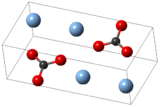Silver carbonate

| |

| |
| Names | |
|---|---|
| IUPAC name
Silver(I) carbonate, Silver carbonate
| |
| Identifiers | |
3D model (JSmol)
|
|
| ChemSpider | |
| ECHA InfoCard | 100.007.811 |
| EC Number |
|
| MeSH | silver+carbonate |
PubChem CID
|
|
| UNII | |
CompTox Dashboard (EPA)
|
|
| |
| |
| Properties | |
| Ag2CO3 | |
| Appearance | Pale yellow crystals |
| Odor | Odorless |
| Density | 6.077 g/cm3[1] |
| Melting point | 218 °C (424 °F; 491 K) decomposes from 120 °C[1][4] |
| 0.031 g/L (15 °C) 0.032 g/L (25 °C) 0.5 g/L (100 °C)[2] | |
Solubility product (Ksp)
|
8.46·10−12[1] |
| Solubility | Insoluble in alcohol, liquid ammonia, acetates, acetone[3] |
| −8.09·10−5 cm3/mol[1] | |
| Structure | |
| Monoclinic, mP12 (295 K) Trigonal, hP36 (β-form, 453 K) Hexagonal, hP18 (α-form, 476 K)[5] | |
| P21/m, No. 11 (295 K) P31c, No. 159 (β-form, 453 K) P62m, No. 189 (α-form, 476 K)[5] | |
| 2/m (295 K) 3m (β-form, 453 K) 6m2 (α-form, 476 K)[5] | |
a = 4.8521(2) Å, b = 9.5489(4) Å, c = 3.2536(1) Å (295 K)[5] α = 90°, β = 91.9713(3)°, γ = 90°
| |
| Thermochemistry | |
Heat capacity (C)
|
112.3 J/mol·K[1] |
Std molar
entropy (S⦵298) |
167.4 J/mol·K[1] |
Std enthalpy of
formation (ΔfH⦵298) |
−505.8 kJ/mol[1] |
Gibbs free energy (ΔfG⦵)
|
−436.8 kJ/mol[1][4] |
| Hazards | |
| Occupational safety and health (OHS/OSH): | |
Inhalation hazards
|
Irritant |
| GHS labelling: | |
 [6] [6]
| |
| Warning | |
| H315, H319, H335[6] | |
| P261, P305+P351+P338[6] | |
| NFPA 704 (fire diamond) | |
| Lethal dose or concentration (LD, LC): | |
LD50 (median dose)
|
3.73 g/kg (mice, oral)[7] |
Except where otherwise noted, data are given for materials in their standard state (at 25 °C [77 °F], 100 kPa).
| |
Silver carbonate is the chemical compound with the formula Ag2CO3. Silver carbonate is yellow but typical samples are grayish due to the presence of elemental silver. It is poorly soluble in water, like most transition metal carbonates.
Preparation
Silver carbonate can be easily prepared by combining aqueous solutions of sodium carbonate with a deficiency of silver nitrate.[8] Freshly prepared silver carbonate is colourless, but the solid quickly turns yellow.[9] It reacts with ammonia to give the explosive silver fulminate. With hydrofluoric acid, it gives silver fluoride.
Uses
The principal use of silver carbonate is for the production of silver powder for use in microelectronics. It is reduced with formaldehyde, producing silver free of alkali metals:[9]
- Ag2CO3 + CH2O → 2 Ag + 2 CO2 + H2
Silver carbonate is used as a reagent in organic synthesis such as the Koenigs-Knorr reaction. In the Fétizon oxidation, silver carbonate on celite acts as an oxidising agent to form lactones from diols. It is also employed to convert alkyl bromides into alcohols.[8]
References
- ^ a b c d e f g h Lide, David R., ed. (2009). CRC Handbook of Chemistry and Physics (90th ed.). Boca Raton, Florida: CRC Press. ISBN 978-1-4200-9084-0.
- ^ Seidell, Atherton; Linke, William F. (1919). Solubilities of Inorganic and Organic Compounds (2nd ed.). New York City: D. Van Nostrand Company. p. 605.
- ^ Comey, Arthur Messinger; Hahn, Dorothy A. (1921-02). A Dictionary of Chemical Solubilities: Inorganic (2nd ed.). New York: The MacMillan Company. p. 203.
{{cite book}}: Check date values in:|date=(help) - ^ a b Anatolievich, Kiper Ruslan. "silver nitrate". http://chemister.ru. Retrieved 2014-07-21.
{{cite web}}: External link in|website= - ^ a b c d Norby, P.; Dinnebier, R.; Fitch, A.N. (2002). "Decomposition of Silver Carbonate; the Crystal Structure of Two High-Temperature Modifications of Ag2CO3". Inorganic Chemistry. 41 (14). doi:10.1021/ic0111177.
- ^ a b c Sigma-Aldrich Co., Silver carbonate. Retrieved on 2014-05-06.
- ^ a b "Silver Carbonate MSDS". http://www.saltlakemetals.com. Salt Lake City, Utah: Salt Lake Metals. Retrieved 2014-06-08.
{{cite web}}: External link in|website= - ^ a b McCloskey C. M.; Coleman, G. H. (1955). "β-d-Glucose-2,3,4,6-Tetraacetate". Organic Syntheses
{{cite journal}}: CS1 maint: multiple names: authors list (link); Collected Volumes, vol. 3, p. 434. - ^ a b Andreas Brumby et al. "Silver, Silver Compounds, and Silver Alloys" in Ullmann's Encyclopedia of Industrial Chemistry, Wiley-VCH, Weinheim, 2008. doi:10.1002/14356007.a24_107.pub2

